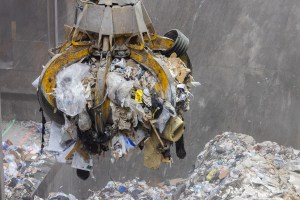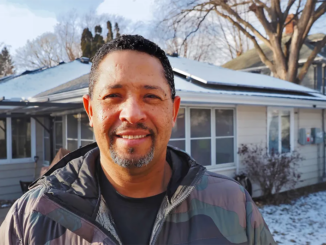
This story comes to you from Sahan Journal, a nonprofit newsroom dedicated to covering Minnesota’s immigrants and communities of color. Sign up for Sahan’s free newsletter to receive stories in your inbox.
When Minnesota legislators passed a law committing to 100 percent clean energy by 2040, they included a small but important provision: Hennepin County’s waste to energy trash incinerator can no longer be considered a source of renewable energy.
The move represented a significant victory for the environmental justice movement in the Twin Cities. The Hennepin Energy Recovery Center, widely known as the HERC, is a pollution source located on the edge of the North Loop neighborhood in downtown Minneapolis, that impacts residents of the north side and downtown.
Since its construction in the late 1980s, the facility has been criticized by climate organizers who say its pollution is most felt by Minnesotans of color who experience lower air quality and poorer health outcomes.
“That was legislators hearing community and stepping up,” said Nazir Khan with the Minnesota Environmental Justice Table, a nonprofit organization that campaigns against incinerators across the state.
Sign up for Energy News Weekly
Get the most important energy news of the week delivered directly to your inbox.
Now, Hennepin County is in the midst of creating a zero waste plan that aims to divert 90 percent of all waste from landfills and incinerators. But officials have been hesitant to put a deadline on closing the controversial incinerator that they say plays a vital role in managing trash in the state’s largest county.
“We hope we get to a position where facilities like HERC and landfills are no longer required,” said Dave McNary, assistant director of Hennepin County’s energy and environment department.
Environmental justice advocates say the new law and the pending zero waste plan are creating a ripe opportunity for the county to announce a timeline to shut the facility. But many in the fight say the county is not pushing hard enough to make closing the incinerator a viable option.
Hennepin County leaders know the law will change operations for the HERC at some level, but are still determining what that impact will be.
“Given the recent passage of the Clean Energy Bill and the growing momentum to address environmental justice concerns, Hennepin must carefully consider how to responsibly and proactively respond. These conversations are already underway, and I expect to be able to share more concrete commitments within a year,” Irene Fernando, chair of the Hennepin County Board of Commissioners, said in a statement to Sahan Journal.
The HERC and Minnesota’s six other incinerators are waste-to-energy facilities. The HERC burns trash to create steam, which is used to heat its neighbor, baseball stadium Target Field, and parts of the North Loop. The steam is also converted into energy, which is sold to Xcel Energy. For decades, state law deemed the facilities a source of renewable energy.
While the state’s six other incinerators maintain that status, waste experts and environmental justice advocates cheered the change in the HERC’s designation in Minnesota’s new clean energy law. The clean energy bill stipulated that incinerators could not be considered sources of renewable energy if they were located near an environmental justice community defined by income and racial diversity benchmarks.
For the county, the HERC’s purpose is to manage solid waste, and energy production is considered a secondary benefit, according to McNary. The HERC manages 365,000 tons of trash each year, about 45 percent of all waste produced in the county.
The HERC will no longer be able to sell renewable energy credits based on the power it produces, but that change is not expected to impact their bottom line, McNary said. Revenue from credits reached $2.5 million in 2017, but the county hasn’t earned any money on credits since 2018, according to McNary and financial documents.
The HERC is a profitable operation that primarily earns money through a payment known as tipping fees when waste haulers deposit garbage at the facility fees. This year the facility projects to make $25.1 million in tipping fees. The facility also earns between $3 million to $8 million annually selling electricity, and makes money by selling steam and scrap metal salvaged from the trash.
“We never depend on renewable energy credits,” McNary said.
The county will pay Great River Energy $25.1 million to operate the HERC for 2023, which covers supplies, commodities, and labor costs for 56 workers, including 38 members of the International Brotherhood of Electrical Workers. The HERC will also spend $2.8 million disposing of ash in a specialized landfill.
While the new law might not change the financial outlook of the HERC, the designation is more in line with scientific reality, according to professor Sintana Vergara, who studies waste at Humboldt State University. Renewable energy comes from natural sources like water, wind, and sunlight—incineration of trash is essentially the opposite, she said.
“You’re burning plastic and paper,” Vergara said.
Minnesota’s new law is a major step forward for the climate movement, but it will not enforce a total shutdown on all polluting energy facilities. Producers will still be able to offset emissions from polluting facilities with renewable energy credits from clean sources. Minnesota is awash with renewable energy credits, according to Hudson Kingston, an Ely -based environmental lawyer with PEER, Public Employees for Environmental Responsibility.
Great River Energy operates large wind power facilities in the Dakotas that generate renewable credits it could use to keep the HERC running and stay in compliance with Minnesota law, he said.
Inside the HERC, the smell of mixed trash quickly overwhelms the nostrils before settling into a bearable background stench. Dump trucks from public trash collectors and private contractors weigh in and back their vehicles up to a lasered tipping line. Their loads are dumped on the edge of a massive trash pit, and are pushed into the pile by front-loading tractors.
A large crane plucks up the waste, like a giant claw machine digging for stuffed animals at an arcade, and drags it to a loader to be burned. The waste consists of hundreds of bags of trash, broken furniture, apple cores, and thousands of miscellaneous items and papers.
“As you look at our pile, you see a lot of recyclable material,” said Randy Kiser, administrative manager for the HERC.
Workers at the HERC try to separate out major recyclable materials, Kiser said. He pointed to an industrial paper roll that the crane operator had set aside that will be recycled, but a lot slips through the cracks and gets burned.
Kiser and McNary have nearly 60 years of combined experience with Hennepin County waste management. While there have been improvements in local recycling in that time, both say the progress hasn’t been that significant.
The county knows the HERC is a source of greenhouse gas emissions, and says it does its best to control that pollution. This is done with a series of pollution mitigation techniques, but also by controlling the fires that burn the trash. Burning at higher temperatures helps regulate emissions. In a large control room inside the HERC, employees from Great River Energy can see emission levels of various pollutants in real time, and can tweak the fire to try to make the trash burn cleaner.
But burning trash is inherently not clean, Vergara said. The HERC is a significant pollution source in Minneapolis, according to data from the Minnesota Pollution Control Agency. In 2021, it produced 403 tons of nitrogen oxide, which is known to cause asthma, and produced 180,000 tons of carbon dioxide emissions, a leading cause of global warming.
The facility also releases lead, mercury, and particulate matter under 2.5 microns (PM 2.5), which are tiny particles that have negative health impacts when inhaled. The HERC regularly stays well under permitted pollution levels, Kiser said.
The HERC experienced a spike in mercury emissions in 2021, according to the pollution control agency’s “Air We Breathe” report, but still was under its permitted levels for the substance.
Minneapolis residents organizing against the HERC want the county to officially commit to a deadline to close the facility. But neither the county’s climate action plan of 2021 nor the draft of its zero waste plan commit to closing the incinerator.
“There’s this incredible wariness to bring a shutdown date,” Khan said.
For waste management professionals like McNary, the realities of current consumption patterns and trash build up among average residents present a daunting challenge. The average county resident produces 2,000 pounds of trash per year, and that trash needs to be handled.
Participants in the zero waste draft plan feel that leaders in county waste management were not taking the steps needed to really move toward a HERC-free future.
“I feel like a lot of onus is put on the community to provide answers to questions the county should be answering on its own,” said Charles Frempong-Longdon with Minnesota Environmental Justice Table.
The Hennepin County Climate Action Plan said the county sees the HERC as preferable to burying garbage in landfills, because it says the centralized location minimizes vehicle emissions for haulers, recaptures scrap metal, and reduces methane emissions from landfills.
For environmental justice organizers, a crucial component of the impact of incinerators is their proximity to underserved communities disproportionately inhabited by people of color.
While officials are hesitant to put forth a shutdown date without clear alternatives for places to put the trash, advocates and experts say deadlines can be great motivators to solving issues.
“If you don’t set the goal, you’re certainly not going to do it,” Vergara said.
But leaders are considering more definite moves to closing the HERC. The final zero waste plan is expected to be presented to the county board in May, and the board will vote on it as part of a broader solid waste management plan.
“In order to be responsive to residents’ concerns and advance our climate action goals, it’s clear that Hennepin County must take serious steps toward closing the Hennepin Energy Recovery Center,” Fernando said.
Today, 39 percent of all waste in Hennepin County is diverted from incinerators and landfills by recycling and composting. The county’s current goal is to raise that level to 75 percent by 2030. But the zero waste plan is aiming to create a future where 90 percent of all waste can be diverted.
Getting there will take policy and cultural shifts. Hennepin County’s zero waste draft plan organizes steps to achieving zero waste into three stages. There are easier goals like increasing recycling and organics recycling participation in multifamily buildings and increasing education in specific communities.
And there are more complex milestones like adding options for bulk item collection and electronics recycling, and connecting building companies and architects to programs that enable them to reuse more materials.
Two easier items, called “low hanging fruit” in the draft plan, include establishing milestones to phase out the HERC as the county approaches zero waste, and to evaluate short-term upgrades that would reduce pollution from the HERC.
“We need strong partnership and state leadership on a range of zero waste policies. We need to require manufacturers and businesses to be responsible for the packaging waste they create. We need recycling and composting services accessible to all residents at an appropriate scale, especially for apartment or office buildings,” Fernando said.
Two strategies are critical for reaching zero waste, Vergara said. One is source reduction: society needs to produce less waste by designing more durable products and repairing and reusing what we already have. The second is source separation: making sure compost is compost, or that paper is properly recycled and not mixed with other waste that can make it unrecyclable.
“The culture and the moment we live in now is one of tremendous waste generation and consumption,” Vergara said.



